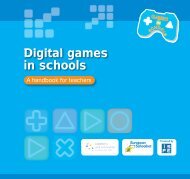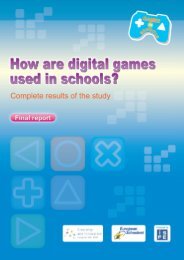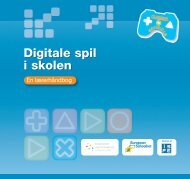Quels usages pour les jeux électroniques en classe ? - Games in ...
Quels usages pour les jeux électroniques en classe ? - Games in ...
Quels usages pour les jeux électroniques en classe ? - Games in ...
You also want an ePaper? Increase the reach of your titles
YUMPU automatically turns print PDFs into web optimized ePapers that Google loves.
Korczyn, A. D., Peretz, C., Aharonson, V., & Giladi, N. (2007). Computer based cognitive tra<strong>in</strong><strong>in</strong>g with m<strong>in</strong>dfit<br />
improved cognitive performances above the effect of classic video games; prospective,<br />
randomized, double-bl<strong>in</strong>d <strong>in</strong>terv<strong>en</strong>tion study <strong>in</strong> the elderly. Paper pres<strong>en</strong>ted at the 8th<br />
International Confer<strong>en</strong>ce AD/PD 2007, Salzburg, Austria.<br />
L<strong>en</strong>non, J.L., & Coombs, D.W. (2006), Child-<strong>in</strong>v<strong>en</strong>ted health education games: A case study for d<strong>en</strong>gue<br />
fever. Simulation & Gam<strong>in</strong>g. An Interdiscipl<strong>in</strong>ary Journal of Theory, Practice and Research.<br />
37(1), 88-97<br />
Levy, F., & Murnane, R. (2004). The New Division of Labor: How Computers are Creat<strong>in</strong>g the Next Job<br />
Market. Pr<strong>in</strong>ceton, NJ: Pr<strong>in</strong>ceton University Press.<br />
L<strong>in</strong>ser, R. (2008) The Magic Circle – Game Design Pr<strong>in</strong>cip<strong>les</strong> and Onl<strong>in</strong>e Role-Play Simulations.<br />
Proceed<strong>in</strong>gs of World Confer<strong>en</strong>ce on Educational Multimedia, Hypermedia and<br />
telecommunications 2008 Vi<strong>en</strong>na, Austria, 2008, pp. 5290-97.<br />
Noble, A., Best, D., Sidwell, C., & Strang, J. (2000). Is an arcade-style computer game an effective medium<br />
for provid<strong>in</strong>g drug education to school childr<strong>en</strong>? Education for Health, 13(3), 404-06.<br />
Nova, N. (2001). Awar<strong>en</strong>ess tools: Lessons from quake-like. Paper pres<strong>en</strong>ted at the Play<strong>in</strong>g with the Future<br />
Confer<strong>en</strong>ce, Manchester, UK.<br />
McMahan, A. (2003). Immersion, <strong>en</strong>gagem<strong>en</strong>t, and pres<strong>en</strong>ce: A method for analyz<strong>in</strong>g 3-d video games. In<br />
M. J. P. Wolf & B. Perron (Eds.), The video game theory reader (pp. 67-86). New York:<br />
Routledge.<br />
Magnuss<strong>en</strong>, R. (2007). Teacher ro<strong>les</strong> <strong>in</strong> learn<strong>in</strong>g games - Wh<strong>en</strong> games become situated <strong>in</strong> schools. Digital<br />
<strong>Games</strong> Research Association 2007 Confer<strong>en</strong>ce: Situated Play, Tokyo, 610-15.<br />
Malone, T. W. (1981). What makes video games fun? Byte, 6(12), 258-77.<br />
Malone, T. W., & Lepper, M. R. (1987). Aptitude, learn<strong>in</strong>g and <strong>in</strong>struction iii: Cognitive and affective process<br />
analysis. Hillsdale, NJ: Lawr<strong>en</strong>ce Erlbaum Associates.<br />
Mas<strong>en</strong>dorf, F. (1995). Tra<strong>in</strong><strong>in</strong>g learn<strong>in</strong>g-disabled childr<strong>en</strong>'s spatial ability by computer games. European<br />
Education, Summer 27(2), 49.<br />
Mayer, I. & Bekebreda, G. (2006). Serious games and simulation based e-learn<strong>in</strong>g for <strong>in</strong>frastructure<br />
managem<strong>en</strong>t. In M. Pivec (Ed.), Affective and emotional aspects of human-computer <strong>in</strong>teraction:<br />
Emphasis on game-based and <strong>in</strong>novative learn<strong>in</strong>g approaches. Amsterdam: IOS Press BV.<br />
M<strong>en</strong>n, D. (1993) Multimedia <strong>in</strong> Education: Arm<strong>in</strong>g Our Kids for the Future. PC World 11 (October, 1993).<br />
McK<strong>en</strong>zie, J. (2007). Digital Nativism Digital Delusions and Digital Deprivation. The Education Technology<br />
Journal, 17(2).<br />
McMull<strong>en</strong>, D. (1987). Drills vs. <strong>Games</strong> - Any Differ<strong>en</strong>ces? A Pilot Study. (ERIC Docum<strong>en</strong>t Reproduction<br />
Service No. ED #335355.)<br />
Mitgutsch, K. (2007). Digital play-based learn<strong>in</strong>g; A philosophical-pedagogical perspective on learn<strong>in</strong>g anew.<br />
Paper pres<strong>en</strong>ted at the <strong>Games</strong> <strong>in</strong> Action Confer<strong>en</strong>ce, Goth<strong>en</strong>burg, Swed<strong>en</strong>.<br />
Mitra, S. & Rana, V. (2001) Childr<strong>en</strong> and the Internet: Experim<strong>en</strong>ts with m<strong>in</strong>imally <strong>in</strong>vasive education <strong>in</strong> India.<br />
The British Journal of Educational Technology, 32(2), 221-32.<br />
Moore, B. D. (2005). Neurocognitive outcomes <strong>in</strong> survivors of childhood cancer. Journal of Pediatric<br />
Psychology, 30(1), 51-63.<br />
158






